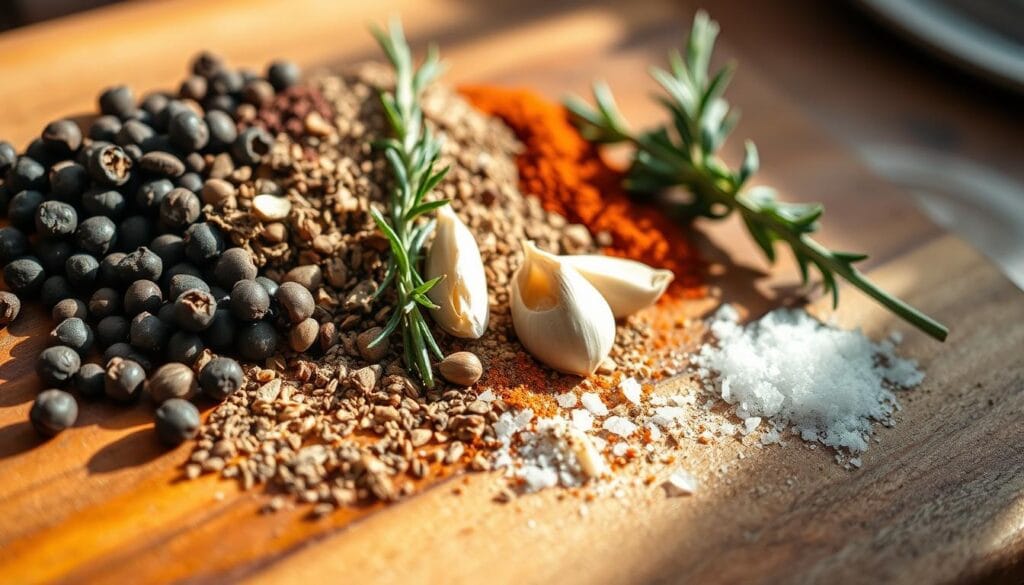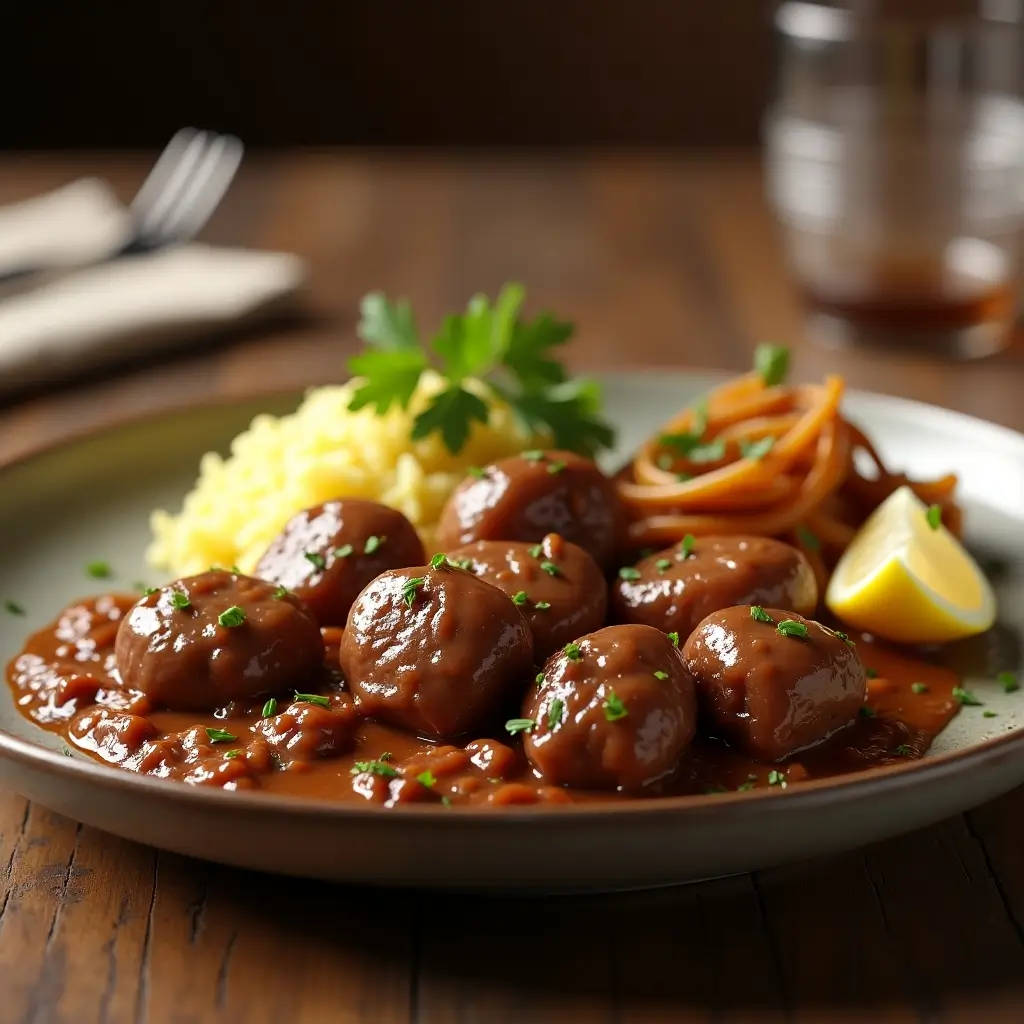Secrets to Cooking Beef Kidney Made Delicious
Imagine turning an often overlooked ingredient into a culinary gem. Beef kidney, rich in nutrients, is waiting to delight your taste buds. It has a unique flavor that can make your dishes stand out.
Organ meats have been a key part of many cuisines for years. They bring important nutrients and cultural value. Learning to cook beef kidney can take your cooking to new heights and introduce you to exciting recipes.
Table of Contents
Understanding Beef Kidney: A Nutrient-Rich Delicacy
Beef kidney is a standout in beef variety meats, packed with nutrients. It boosts your diet with essential health benefits. This organ meat is a powerhouse of vitamins and minerals.
Health Benefits and Nutritional Value
Kidney nutrition is more than just protein. A single serving is full of vitamins and minerals. These are key for your body to work its best.
- High-quality protein source
- Rich in vitamin B12
- Excellent source of iron
- Contains selenium and phosphorus
Secrets to Cooking Beef Kidney
Experts say to eat beef kidney in moderation. Aim for 6 to 8 ounces a week. This balance ensures you get the benefits without overdoing it.
Selecting Fresh Beef Kidneys
When buying beef kidneys, look for these qualities:
- Color: Deep red to burgundy
- Texture: Firm and smooth
- Smell: Fresh, without strong odors
Storage and Shelf Life
Keeping beef kidney fresh is key. Store it in the fridge right away. Use it within 1-2 days, or freeze for up to 3 months to keep its nutrients.
| Storage Method | Duration | Recommended Handling |
|---|---|---|
| Refrigeration | 1-2 days | Keep in sealed container |
| Freezing | Up to 3 months | Wrap tightly in freezer paper |
Essential Preparation Steps Before Cooking
Preparing beef kidney for cooking needs careful steps. Start by cleaning it well and handling it right. This ensures the best taste and texture. Professional chefs say the right prep makes this meat a tasty dish.
Here are the key steps to prepare your beef kidney:
- Rinse the beef kidney under cold water
- Trim off excess fat and white membrane
- Remove any connective tissues
- Pat dry with paper towels
Soaking the kidney is optional but helps. Use a mix of cold water, white vinegar, and salt to soak it. This makes the strong flavor of organ meats milder.
| Ingredient | Purpose | Quantity |
|---|---|---|
| Cold water | Base liquid | 4 cups |
| White vinegar | Flavor neutralizer | 2 tablespoons |
| Salt | Mild tenderizer | 1 teaspoon |
Soak the kidney for at least 2 hours. This step makes the flavor more enjoyable, especially for those trying organ meats for the first time.
Pro tip: Always buy fresh beef kidneys from a trusted butcher. Check them for quality before you start.
How to Cook Beef Kidney: Step-by-Step Guide
Cooking beef kidney is a fun adventure for those eager to try offal dishes. It needs patience, skill, and the right preparation. This guide will show you how to make this protein-rich food into a tasty meal.
Cleaning and Trimming Techniques
First, clean the beef kidney well. Rinse it under cold water to get rid of dirt. Then, use a sharp knife to cut off fat and connective tissue. This makes the pieces clean and even for cooking.
- Rinse kidney thoroughly under cold running water
- Remove white membrane and visible fat
- Cut into uniform pieces for consistent cooking
- Pat dry with paper towels to ensure better browning
Soaking Methods to Reduce Strong Flavors
Soaking is key to making beef kidney taste better. Mix water and vinegar to create a soaking solution. Use:
| Ingredient | Quantity | Purpose |
|---|---|---|
| Water | 1 liter | Base liquid |
| Vinegar | 1/2 cup | Neutralize strong odors |
Soak the kidney for at least two hours. Change the liquid halfway. This removes strong tastes and gets the meat ready for cooking.
Basic Cooking Instructions
There are many ways to cook beef kidney, but sautéing is the most popular. It’s quick and adds flavor.
- Heat a skillet with butter or oil
- Cook kidney pieces over medium heat
- Aim for 3-5 minutes per side
- Season with garlic powder, black pepper, and herbs
Pro tip: Always cook beef kidney to medium doneness to maintain tenderness and avoid a tough texture.
Try different cooking methods like grilling, stewing, or baking. Each way gives a unique taste. This turns the nutrient-rich kidney into a memorable meal.
Classic French Cooking Methods for Beef Kidney
French cuisine turns beef offal into art, making beef kidney a tasty treat. Traditional French recipes show off the meat’s unique taste. They use advanced techniques to make it stand out.

French chefs are experts at making beef kidney dishes. The top one is Rognons à la Crème. It mixes tender beef kidney with a creamy sauce.
- Carefully clean and trim beef kidneys to remove membranes
- Soak kidneys in milk to reduce strong gamey flavor
- Slice kidneys into thin, uniform pieces for even cooking
- Use high-heat cooking methods like sautéing or quick broiling
French cooking focuses on quick, high-heat methods. This keeps the meat tender and adds a nice crust. It also keeps the inside juicy.
Classic French beef kidney dishes often include:
- Fresh beef kidneys
- Butter or olive oil
- Shallots
- Fresh herbs like parsley
- Heavy cream
- Dijon mustard
Exploring beef offal cooking can turn these ingredients into gourmet dishes. French techniques make it possible.
Popular Beef Kidney Recipes Around the World
Beef kidney dishes take you on a tasty journey around the globe. These dishes are packed with nutrients and show how versatile beef kidney can be.
Every place has its own way of making kidney dishes. They turn this protein-rich meat into dishes that amaze and please food explorers.
Traditional British Steak and Kidney Pie
The British steak and kidney pie is a beloved comfort food. It’s big enough for 6-8 people and needs:
- 1-1/2 pounds beef chuck roast
- 1/2 pound ox or veal kidneys
- 2-2/3 cups all-purpose flour
- 20 tablespoons butter
To make it, simmer for 2-3 hours and then bake at 400°F for 40-45 minutes. Pro tip: Soak kidneys in milk for 30 minutes to reduce their intense flavor.
French Rognons à la Crème
The French take beef kidney to new heights with Rognons à la Crème. This dish pairs perfectly cooked kidneys with a creamy sauce. It turns the organ meat into a fancy dish.
Asian-Inspired Kidney Dishes
Asian cooking brings exciting twists to kidney recipes. From spicy Indian curries to light Chinese stir-fries, these dishes show how well kidneys adapt. They use quick cooking to keep the meat tender.
Whether you love trying new foods or want to learn more recipes, these beef kidney dishes are a flavorful journey around the world.
Best Seasonings and Flavor Combinations

Cooking beef kidney needs a smart seasoning plan. Its strong flavor calls for careful balancing to make tasty dishes. These dishes will delight adventurous cooks at home.
To tame beef kidney’s bold taste, use the right seasonings. The trick is to mix ingredients that boost the meat’s flavor without overwhelming it.
Top Seasoning Strategies
- Use acidic ingredients like vinegar or lemon juice to cut through the intense flavor
- Incorporate robust herbs that stand up to the kidney’s distinctive taste
- Balance strong flavors with creamy or mild accompaniments
Recommended Flavor Combinations
| Seasoning Group | Key Ingredients | Flavor Profile |
|---|---|---|
| Classic French | Dijon mustard, fresh parsley, black pepper | Sharp and aromatic |
| Mediterranean | Garlic, rosemary, red wine vinegar | Herbaceous and tangy |
| Asian-Inspired | Ginger, soy sauce, green onions | Umami and bright |
Seasoning beef kidney is an art. Try various mixes to find your favorite taste. Aim for a dish that highlights the kidney’s special traits and is enjoyable to eat.
Common Cooking Mistakes to Avoid
Learning to cook beef kidney needs precision and careful technique. Many home cooks face challenges with this unique organ meat. They often make mistakes that make the dish tough and unappetizing.
When preparing beef kidney, knowing common mistakes is key to success. Here are tips to help you avoid common cooking challenges.
Temperature Control Tips
Beef kidney needs careful heat management. Cooking it too hot can make it tough and rubbery. Here are some strategies:
- Use medium-low heat for even cooking
- Avoid direct high-heat methods
- Monitor internal temperature closely
Timing and Texture Considerations
Getting the right texture in beef kidney takes precise timing. Overcooking by just a few minutes can ruin its tenderness. Aim for a slightly pink center to keep it moist and soft.
- Cook beef kidney for 3-5 minutes per side
- Rest meat for 2-3 minutes after cooking
- Use a meat thermometer for accuracy
Seasoning Errors to Watch For
Proper seasoning can make your beef kidney dish stand out. Avoid using too much salt or aggressive spices. They can overpower the meat’s delicate flavor.
- Use subtle, complementary herbs
- Salt sparingly before cooking
- Consider marinating to enhance flavor
By avoiding these common mistakes, you can make your beef kidney cooking consistently delicious.
Serving Suggestions and Wine Pairings
Choosing the right wine and side dishes can make your meal special. Bold red wines like Bordeaux or Shiraz go great with beef kidney dishes. A Margaux red wine at 16-18°C is perfect for beef offal.
Classic side dishes make your meal even better. Try creamy mashed potatoes, a French baguette, and steamed green beans with your beef kidney. These add texture and flavor that brings out the organ meat’s unique taste.
Wine lovers will enjoy these pairing tips. For beef kidney recipes, choose strong red wines like Mourvèdre or Cabernet Sauvignon. They balance the kidney’s rich flavor. For lighter preparations, a lighter red wine is better.
When serving beef kidney to new guests, how you present it matters. Slice it nicely, arrange it well, and choose a good wine. This can turn a scary dish into a fun food adventure.
FAQ
What are the primary nutritional benefits of beef kidney?
Beef kidney is packed with high-quality protein and essential nutrients. It’s a great source of vitamin B12, iron, selenium, and zinc. These nutrients support metabolism, immune function, and overall health. A single serving can provide a lot of these important nutrients, making it a great addition to a healthy diet.
How do I remove the strong flavor from beef kidney?
To lessen the strong taste, try soaking the kidney in milk, saltwater, or vinegar for 1-2 hours before cooking. Remove the membrane and white connective tissue thoroughly. Use strong seasonings like mustard, herbs, or cream-based sauces to balance the flavor. Proper cleaning and preparation are essential to enjoy beef kidney.
What are the best cooking methods for beef kidney?
Sauteing, braising, and stewing are the top cooking methods for beef kidney. Quick sauteing works well for tender cuts. Braising and stewing are best for breaking down the meat and enhancing flavors. Cooking it to medium-rare or medium helps keep it tender and prevents it from becoming tough.
How long can I store fresh beef kidney?
Store fresh beef kidney in the fridge for 1-2 days. If you won’t use it right away, freeze it for 3-4 months. Wrap it tightly in freezer-safe packaging and keep it at 0°F or below to preserve quality and prevent bacterial growth.
Is beef kidney safe to eat?
Yes, beef kidney is safe when cleaned, prepared, and cooked right. Get it from trusted butchers or suppliers. Clean and trim it well, and cook to at least 145°F to kill harmful bacteria. People with certain health issues should talk to their doctor before eating organ meats.
What are some traditional dishes that feature beef kidney?
Beef kidney is used in many traditional dishes. The classic British Steak and Kidney Pie and French Rognons à la Crème are favorites. In Asian cuisines, it’s used in hearty, spicy dishes. These recipes show how versatile beef kidney is in different cooking traditions.
Can I substitute beef kidney with another type of meat?
You can replace beef kidney with lamb or veal kidney. If you prefer not to eat organ meats, use lean beef or other proteins. The choice depends on the recipe and your taste preferences.
Have You Given Our Recipe a Try?
There are no reviews yet. Be the first one to write one.

